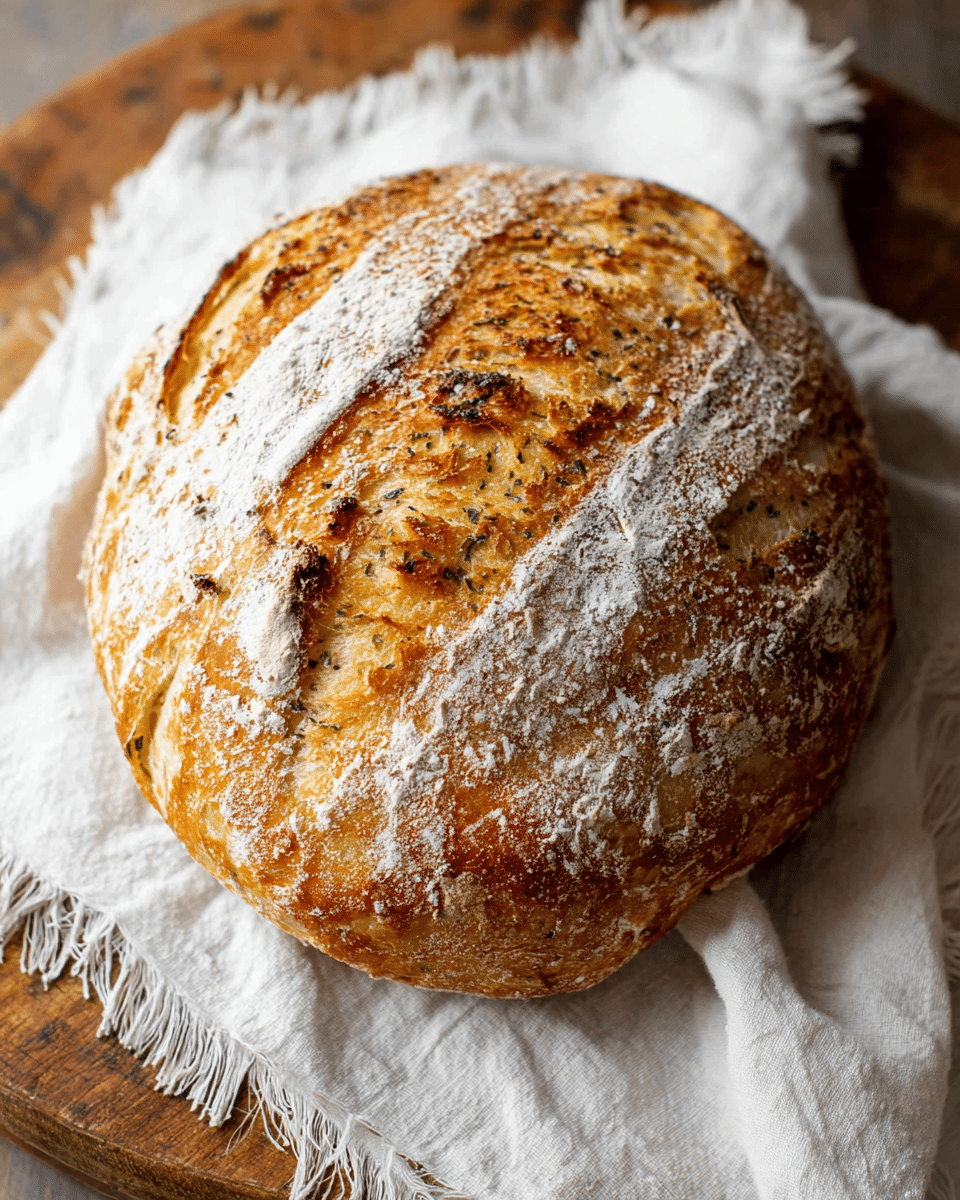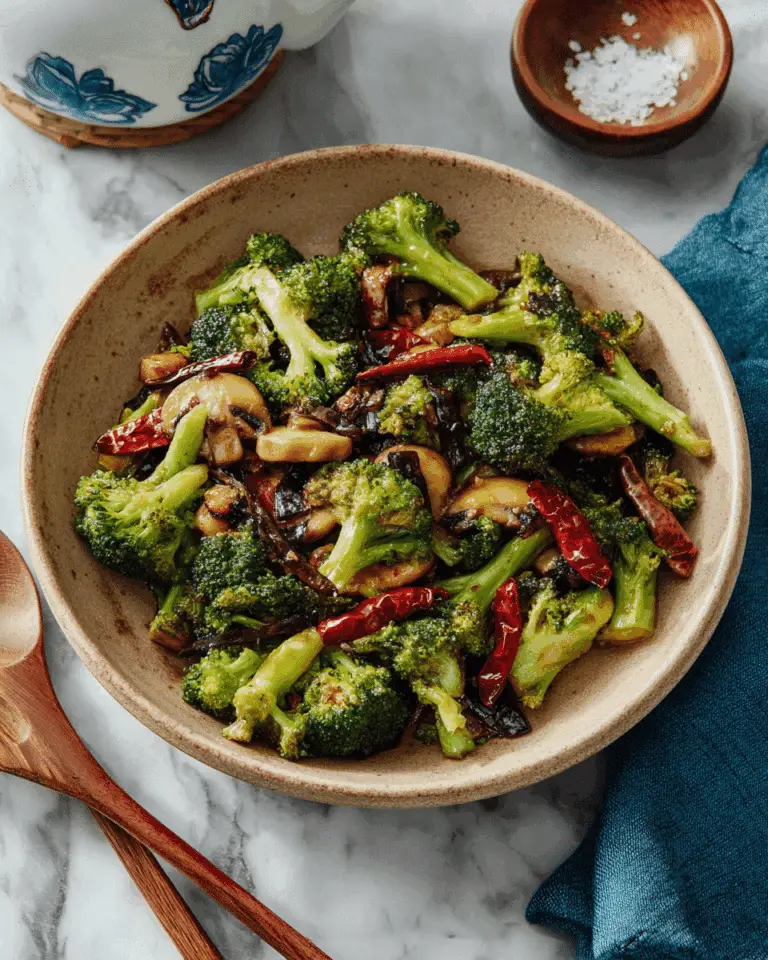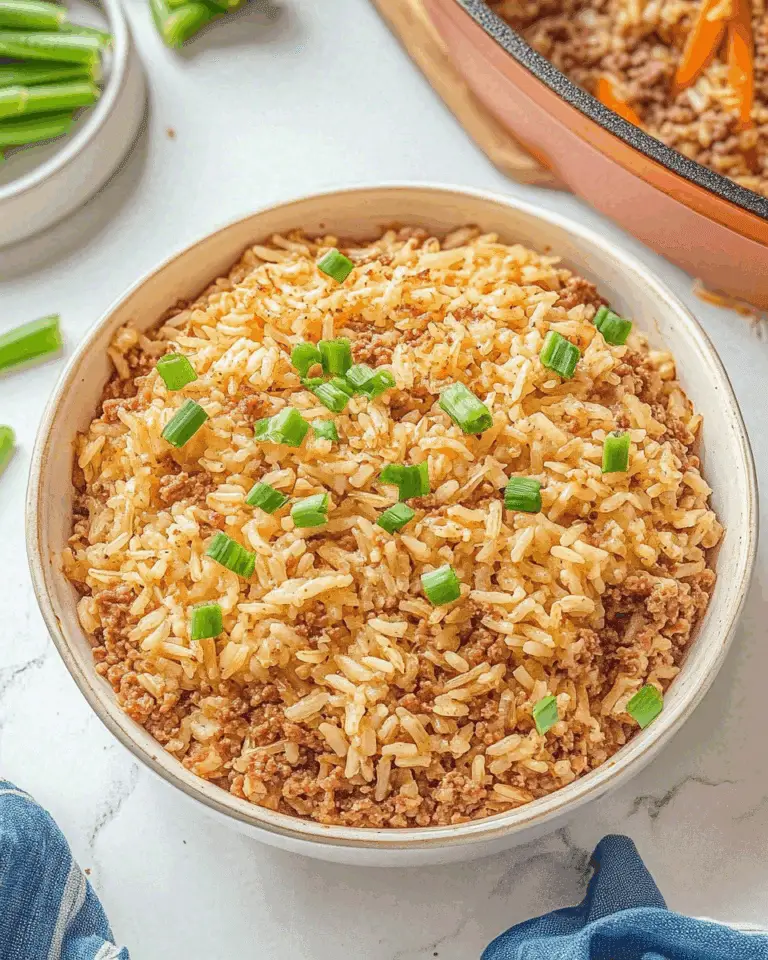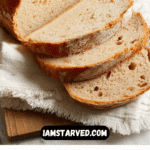I absolutely love making this Garlic Sourdough Bread with Roasted Garlic, Parmesan, and Rosemary Recipe because it takes simple ingredients and transforms them into a loaf packed with incredible depth of flavor. The roasted garlic adds a mellow sweetness and creamy texture, while the parmesan and rosemary create a savory herbal note that makes every slice irresistible. I find that this bread is not only comforting but also versatile enough to enjoy plain, toasted with butter, or as the base for my favorite paninis and avocado toast. It’s truly one of my go-to recipes when I want to impress friends or simply indulge in something spectacularly tasty at home.
Why You’ll Love This Garlic Sourdough Bread with Roasted Garlic, Parmesan, and Rosemary Recipe
What I adore most about this recipe is the beautiful balance of flavors it offers. The sourdough base provides that perfect tangy backdrop, which harmonizes beautifully with the roasted garlic’s subtle sweetness and the nutty, salty crunch of parmesan. The dried rosemary elevates the aroma and adds an herby freshness that really wakes up the palate. Every bite feels comforting yet sophisticated, making it one of my favorite breads to serve for special meals or casual gatherings.
Beyond the flavors, the preparation process feels so rewarding without being complicated. I love how the dough comes together with just a handful of essential ingredients, and the stretch and fold technique really lets you connect with the bread-making tradition. This recipe fits perfectly in my schedule too — I let it rise overnight, so the hands-on time is manageable and the slow fermentation develops complex flavors. Whether I’m making it for a family dinner or a weekend brunch with friends, it’s always a crowd-pleaser that stands out because of its unique combination of roasted garlic, parmesan, and rosemary.
Ingredients You’ll Need
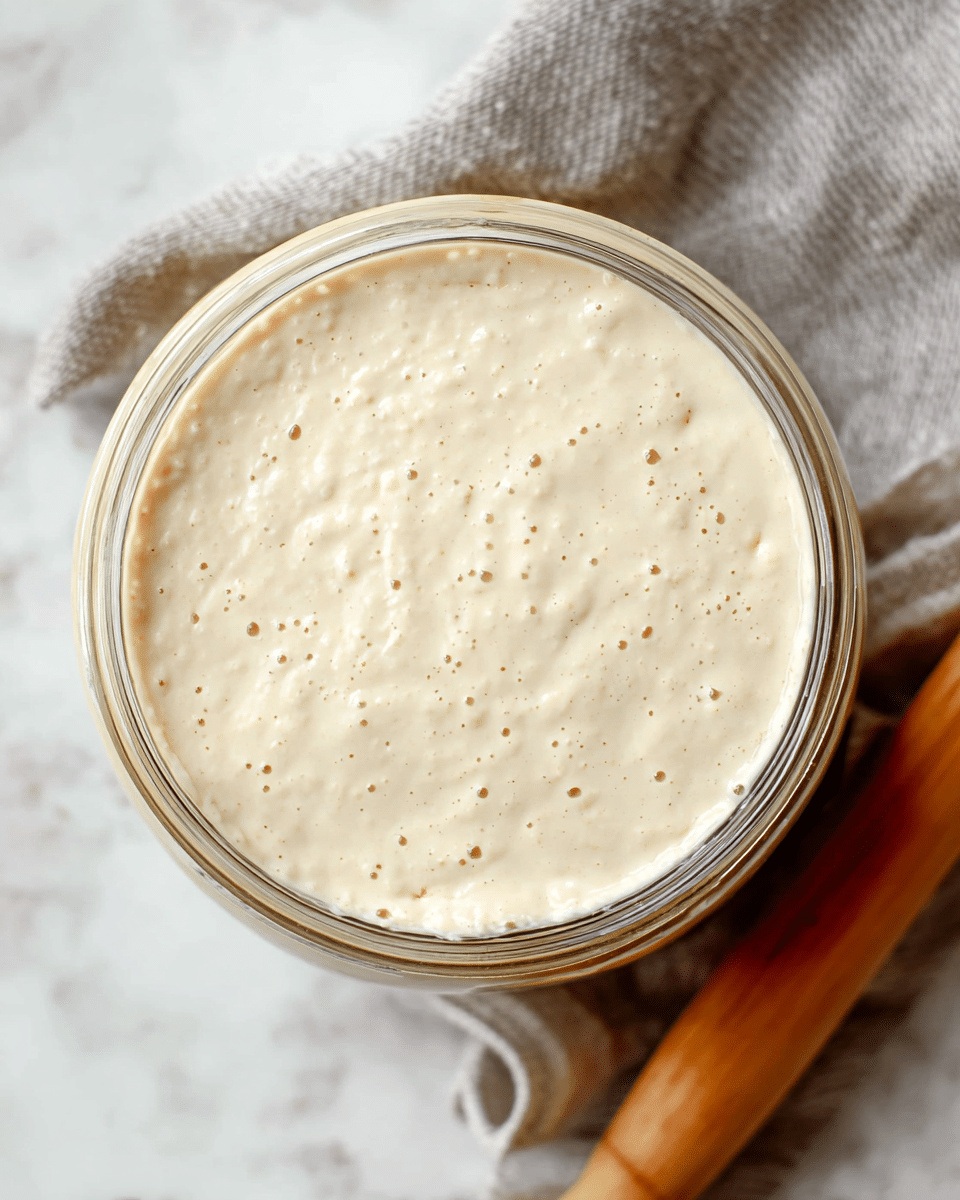
Each ingredient in this Garlic Sourdough Bread with Roasted Garlic, Parmesan, and Rosemary Recipe is chosen carefully to contribute to the overall texture, taste, and character of the loaf. Together, they make a simple but divine combination that I find absolutely essential.
- Bubbly sourdough starter: This fermented culture is the heart of the bread, providing flavor and natural leavening.
- Warm filtered water: Helps hydrate the flours for a perfect dough consistency.
- Bread flour: Gives the bread structure and chewiness thanks to its high protein content.
- Whole wheat flour: Adds a touch of nuttiness and wholesome texture to the bread.
- Fine sea salt: Enhances all the flavors and strengthens gluten development.
- Roasted garlic heads: The star ingredient that infuses the bread with a sweet, mellow garlic flavor.
- Parmesan cheese: Adds a salty, umami punch and a wonderful richness.
- Dried rosemary: Brings in a fragrant, earthy note that perfectly complements garlic and cheese.
Directions
Step 1: Start by roasting the garlic. Slice off the tops of 1 or 2 heads of garlic, drizzle them with olive oil, wrap tightly in foil, and roast in a 400°F oven for about 50 minutes or until soft and golden. Allow to cool slightly, then squeeze out the luscious roasted garlic cloves—these will be folded into your dough for that magical flavor.
Step 2: Shred or cube 100 grams of parmesan cheese using a fine grater or knife. This will melt beautifully, creating pockets of cheesy goodness throughout your bread.
Step 3: In a large mixing bowl, combine the bubbly sourdough starter with warm filtered water and stir well using a fork. Then add the bread flour, whole wheat flour, and fine sea salt. Stir again until the ingredients are roughly incorporated.
Step 4: Use your hands to bring the dough together until it looks shaggy but combined. Cover the bowl with a damp towel and let it rest for 45 minutes. This autolyse stage helps develop gluten and enhances flavor.
Step 5: After the rest, add the roasted garlic, parmesan, and dried rosemary to the dough. Perform stretch and folds by lifting the dough from one side, stretching it up, and folding it onto the center. Turn and repeat this for about 30 seconds to evenly distribute the flavorful additions.
Step 6: Form the dough into a ball, cover it again, and let it rise for 6 to 8 hours or overnight. It should nearly double in size, become soft on top, and show bubbles indicating fermentation.
Step 7: Dust a clean surface lightly with flour and gently tip your dough onto it without deflating the air pockets. Shape it into a round or oblong form depending on your preference and let it rest for five minutes.
Step 8: Gently tighten the dough by pulling it towards you across the surface, rotating as you go to create surface tension. Place the dough seam side up in a bowl lined with a floured towel or banneton basket, cover with a damp towel, and let it rise for another 1 to 2 hours. This second rise adds a bit more volume but no need to double again.
Step 9: Preheat your oven to 450°F. Carefully transfer the dough onto parchment paper, smooth side up. Score the top with a sharp knife or lame to allow for oven expansion.
Step 10: Place the dough with the parchment paper into a preheated Dutch oven, cover with the lid, and bake for 20 minutes. Then remove the lid and bake for an additional 30 to 35 minutes until the crust is deep golden and crisp all around.
Step 11: Remove the bread using the parchment paper as handles and transfer to a wire rack. Let it cool completely before slicing to make sure the crumb sets perfectly and the flavors deepen.
Servings and Timing
This Garlic Sourdough Bread with Roasted Garlic, Parmesan, and Rosemary Recipe makes about 10 hearty slices, perfect for sharing or enjoying over several days. Preparation involves about 30 minutes of active hands-on time, plus a 50-minute roasting and baking phase. The bulk of the effort actually happens during the 6 to 8 hours of bulk fermentation and an additional 1 to 2 hours for the second rise, making the total time around 9 hours and 20 minutes. Resting the bread fully before slicing is essential and typically requires at least an hour.
How to Serve This Garlic Sourdough Bread with Roasted Garlic, Parmesan, and Rosemary Recipe

When I serve this bread, I love to slice it thick and lightly toast it so the parmesan edges get just a little crisp. It’s sensational simply with a pat of butter or alongside a vibrant avocado smash. Its rich garlic and rosemary notes also make it the perfect companion to soups and stews, especially creamy tomato or roasted vegetable varieties. I’ve even used it for sandwiches and paninis, where the strong flavors elevate any filling.
For presentation, I like arranging slices on a wooden board with sprigs of fresh rosemary for a rustic touch. A drizzle of extra virgin olive oil or a side of herb-infused dipping oil adds an inviting shimmer and flavor boost. This bread shines best served slightly warm to room temperature—the cheese is soft, and the garlic aroma is most pronounced, inviting everyone to indulge.
As for beverages, I often pair this bread with a crisp sauvignon blanc or a light red like pinot noir, both of which complement the herbal and cheesy notes beautifully. For non-alcoholic options, a rosemary lemonade or herbal iced tea keeps the flavors bright and fresh. This bread is a true celebration on any table, from casual weeknight dinners to festive holiday gatherings where you want to wow your guests with something special yet approachable.
Variations
I love experimenting with this Garlic Sourdough Bread with Roasted Garlic, Parmesan, and Rosemary Recipe. One favorite twist is swapping the dried rosemary for fresh herbs like thyme or oregano, which give it a slightly different aromatic profile. If I want a bit of heat, I’ll sometimes add a pinch of red pepper flakes to the dough for a subtle kick that plays beautifully with the garlic.
If you’re looking for dietary modifications, I’ve tried making a dairy-free version using a vegan parmesan alternative or nutritional yeast, which works surprisingly well without sacrificing that savory punch. For gluten-free bakers, while traditional sourdough is challenging, I recommend trying a gluten-free sourdough starter and incorporating a mixture of gluten-free flours, though the texture will differ quite a bit from this classic loaf.
If time is tight, you can skip some of the additional stretch and folds—though they really help develop the crumb—and speed up the rise slightly in a warmer spot, just be mindful that faster fermentation can reduce flavor complexity. I’ve also tried baking this bread on a pizza stone instead of a Dutch oven for a crustier finish, which I really enjoyed for a different texture experience.
Storage and Reheating
Storing Leftovers
I store leftover slices in an airtight container or resealable bag at room temperature for up to 3 days. To keep the crust from becoming soggy, I usually avoid wrapping the whole loaf tightly and instead slice as needed. If I plan to keep the bread longer, I prefer refrigerating in a breathable bread box or loosely wrapped in parchment paper inside a container to maintain texture.
Freezing
This bread freezes wonderfully. I like to slice it before freezing and separate layers with parchment paper so I can grab just the number of slices I want later. Wrap slices tightly in plastic wrap or a freezer-safe bag and store for up to 3 months. When you’re ready, thaw at room temperature for a few hours before reheating.
Reheating
To revive the bread’s crisp crust and soft crumb, I recommend reheating in a preheated oven at 350°F for about 10 minutes. If you have slices, toasting them is perfect to bring back the parmesan’s melt and the garlic’s aroma. Avoid using the microwave as it tends to make sourdough rubbery and unevenly heated. Using the oven or toaster ensures you enjoy every bite as if freshly baked.
FAQs
Can I use fresh rosemary instead of dried in this recipe?
Absolutely! Fresh rosemary can be used, but since it’s more potent, I recommend using slightly less—about 1 teaspoon chopped fresh rosemary instead of 2 teaspoons dried. Fresh rosemary adds a brighter, greener note that pairs beautifully with the roasted garlic and parmesan.
How do I know when my sourdough starter is ready to use?
Your starter should be bubbly, active, and at its peak rise—usually about 4 to 6 hours after feeding. It will have a pleasant slightly tangy smell and should float if you drop a spoonful in water. Using a healthy, bubbly starter is key to a good rise and flavor in this bread.
Can I make this bread without a Dutch oven?
Yes! If you don’t have a Dutch oven, you can bake the bread on a preheated pizza stone or a baking sheet. To mimic steam, place a tray with water on the bottom rack of the oven during the first 10-15 minutes of baking. This helps the crust develop that beautiful crispness.
What can I use if I don’t have whole wheat flour?
If you don’t have whole wheat flour, you can simply increase the bread flour by the same amount, but keep in mind you’ll miss out on the nutty flavor and extra texture that whole wheat adds. Another option is to experiment with rye or spelt flour if you have them on hand, which introduces unique flavors to the bread.
Should I slice the bread immediately after baking?
I strongly recommend waiting until the bread has completely cooled before slicing. This cooling period allows the crumb to set and prevents the bread from becoming gummy or squished. Patience here really pays off for the perfect texture in each slice.
Conclusion
Once you try this Garlic Sourdough Bread with Roasted Garlic, Parmesan, and Rosemary Recipe, I guarantee it will become a beloved staple in your kitchen like it is in mine. Its rich flavors, comforting aroma, and satisfying texture make every baking session a joyful experience. I’m so excited for you to taste this loaf and discover just how magical homemade sourdough can be with a little roasted garlic, parmesan, and rosemary magic. Happy baking!
Print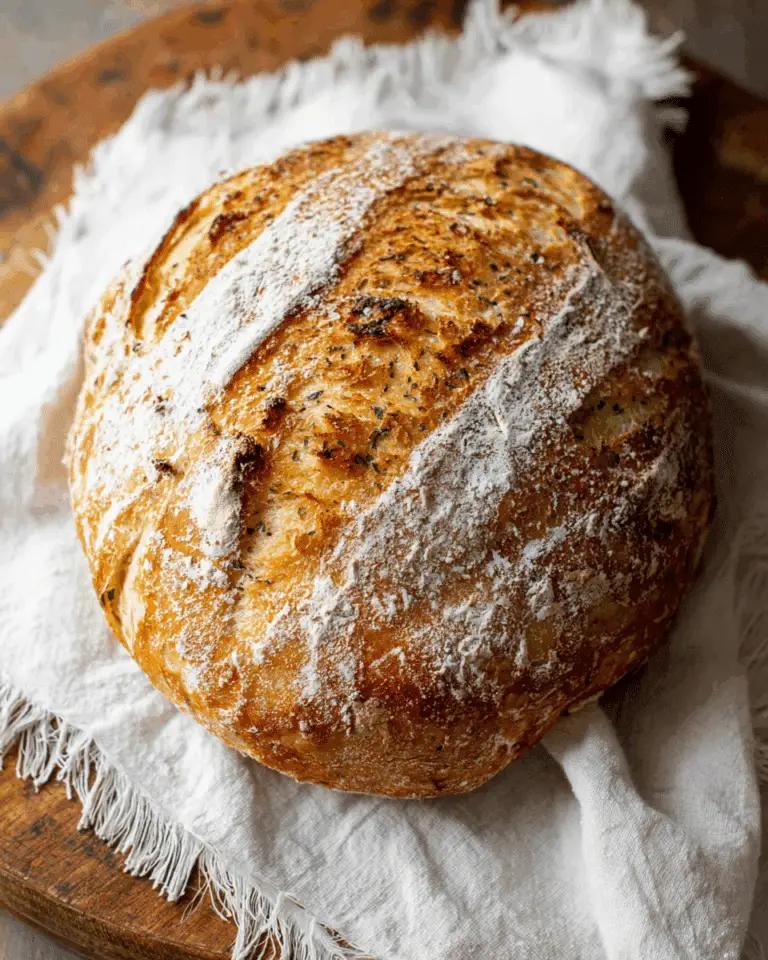
Garlic Sourdough Bread with Roasted Garlic, Parmesan, and Rosemary Recipe
Garlic Sourdough Bread is a savory, flavorful bread that combines a tangy sourdough base with sweet roasted garlic, freshly shredded parmesan cheese, and aromatic dried rosemary. This hearty bread is perfect for making avocado toast or delicious paninis and offers a satisfying texture with a crisp crust and tender crumb.
- Total Time: 9 hours 20 minutes
- Yield: 10 slices
Ingredients
Dough
- 75 grams bubbly sourdough starter
- 365 grams warm, filtered water
- 480 grams bread flour
- 40 grams whole wheat flour
- 10 grams fine sea salt
Flavorings
- 1–2 heads garlic – roasted
- 100 grams parmesan cheese – shredded or cubed
- 2 teaspoons dried rosemary
- Olive oil for roasting garlic
Instructions
- Roast the Garlic: Preheat your oven to 400°F (200°C). Chop off the tops of 1-2 heads of garlic, drizzle the exposed cloves with olive oil, and wrap them tightly in foil. Roast in the oven for about 50 minutes or until the garlic becomes soft and caramelized. Allow to cool slightly, then squeeze out the roasted garlic cloves and set aside for the bread dough.
- Prepare Parmesan: Shred or finely chop 100 grams of parmesan cheese, setting it aside for later use.
- Mix Dough Ingredients: In a large mixing bowl, combine 75 grams of bubbly sourdough starter with 365 grams of warm, filtered water. Stir well with a fork to combine. Add 480 grams bread flour, 40 grams whole wheat flour, and 10 grams fine sea salt. Stir again until incorporated.
- Autolyse: Use your hands to bring the dough together; it will appear shaggy. Cover the bowl with a damp towel and let it sit for 45 minutes to hydrate the flour fully.
- Add Flavorings and Stretch & Folds: After autolyse, add the roasted garlic cloves, shredded parmesan, and 2 teaspoons dried rosemary to the dough. Perform stretch and folds by lifting one side of the dough and stretching it upwards, then folding it over the center. Rotate the bowl and repeat for about 30 seconds, aiming to incorporate the garlic and cheese into the center of the dough. Shape into a smooth ball and cover again with a damp towel.
- Additional Stretch and Folds (Optional): If time allows, perform additional stretch and folds every 30 minutes for 3-4 more times to develop gluten structure further.
- Bulk Fermentation: Let the dough rise for 6-8 hours or overnight at room temperature until it almost doubles in size and appears soft with small air bubbles. Cover with a damp towel to prevent drying, optionally coating the dough top lightly with oil to avoid crust formation.
- Shape the Dough: Lightly dust a clean surface or baking mat with flour. Gently transfer the dough and shape it into your desired form (round or oblong) without punching down to preserve air. Let it rest for 5 minutes.
- Tighten the Dough: After resting, pull the dough toward you on all sides to tighten the surface, rotating as you go, creating a taut outer crust.
- Second Rise: Place the shaped dough seam-side up into a bowl lined with a floured tea towel or a floured banneton basket. Cover with a damp towel and let rest for 1-2 hours until puffy but not doubled in size.
- Prepare to Bake: Preheat your oven to 450°F (230°C). Carefully transfer the loaf onto a piece of parchment paper, smooth side up. Score the top with a serrated knife or bread lame to allow expansion during baking.
- Bake: Place the scored loaf with the parchment paper into a preheated Dutch oven. Cover with the lid and bake for 20 minutes. Remove the lid and continue baking for another 30-35 minutes until the crust is golden and crisp on top and bottom.
- Cool: Remove the Dutch oven from the oven and use the parchment paper as handles to lift the bread out onto a cooling rack. Allow the bread to cool completely before slicing to ensure optimal texture and crumb structure.
Notes
- A digital scale is essential for accurate ingredient measurements in this recipe.
- Prepare your bowl or banneton basket by dusting with rice flour or regular flour to prevent the dough from sticking. Rice flour is preferred for better non-stick performance.
- This recipe is designed for one loaf, but doubling the ingredients allows baking two loaves at once. Adjust starter quantities accordingly (approx. 150 grams for two loaves).
- Do not punch down the dough after bulk fermentation to preserve the air bubbles and structure.
- Ensure the bread cools completely before slicing to avoid gummy texture.
- Prep Time: 30 minutes
- Cook Time: 50 minutes
- Category: Bread
- Method: Baking
- Cuisine: American

